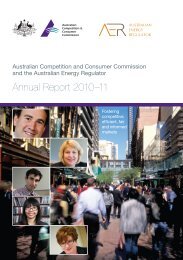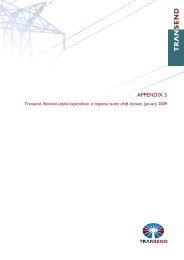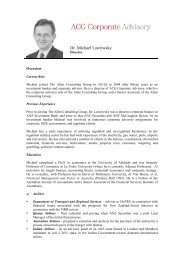Internal consistency of risk free rate and MRP in the CAPM
Internal consistency of risk free rate and MRP in the CAPM
Internal consistency of risk free rate and MRP in the CAPM
You also want an ePaper? Increase the reach of your titles
YUMPU automatically turns print PDFs into web optimized ePapers that Google loves.
…<br />
The Tribunal considers that an averag<strong>in</strong>g period dur<strong>in</strong>g which <strong>in</strong>terest <strong>rate</strong>s were<br />
at historically low levels is unlikely to produce a <strong>rate</strong> <strong>of</strong> return appropriate for <strong>the</strong><br />
regulatory period.<br />
126. It is relevant to note that <strong>the</strong> real <strong>risk</strong> <strong>free</strong> <strong>rate</strong> set <strong>in</strong> <strong>the</strong> AER’s recent Aurora draft<br />
decision is even lower than <strong>the</strong> real <strong>risk</strong> <strong>free</strong> <strong>rate</strong> that was that was <strong>the</strong> subject <strong>of</strong><br />
variation as a consequence <strong>of</strong> <strong>the</strong> merits review brought by <strong>the</strong> NSW distribution<br />
bus<strong>in</strong>esses <strong>and</strong> <strong>the</strong> NSW <strong>and</strong> Tasmanian transmission operators (1.6% versus 1.8%).<br />
I focus on <strong>the</strong> real <strong>risk</strong> <strong>free</strong> <strong>rate</strong> because it is <strong>the</strong> real <strong>risk</strong> <strong>free</strong> <strong>rate</strong> <strong>and</strong> not <strong>the</strong> nom<strong>in</strong>al<br />
<strong>risk</strong> <strong>free</strong> <strong>rate</strong> that determ<strong>in</strong>es <strong>the</strong> nom<strong>in</strong>al level <strong>of</strong> revenues that <strong>the</strong> PTRM cost model<br />
actually delivers to regulated bus<strong>in</strong>esses.<br />
127. In <strong>the</strong>se circumstances, <strong>the</strong> AER’s Aurora draft decision (November 2011) not only<br />
fails to raise <strong>the</strong> <strong>MRP</strong> to at least partially <strong>of</strong>fset <strong>the</strong> impact on <strong>the</strong> cost <strong>of</strong> equity <strong>of</strong><br />
lower <strong>risk</strong> <strong>free</strong> <strong>rate</strong>s result<strong>in</strong>g from a flight from <strong>risk</strong>y assets. In fact, <strong>the</strong> AER decided<br />
to use its discretion to reduce <strong>the</strong> <strong>MRP</strong> from 6.5% as set out <strong>in</strong> <strong>the</strong> SORI to 6.0% -<br />
<strong>the</strong>reby compound<strong>in</strong>g <strong>the</strong> impact <strong>of</strong> <strong>the</strong> fall<strong>in</strong>g CGS <strong>rate</strong>s on <strong>the</strong> allowed cost <strong>of</strong> equity.<br />
128. The table below compares <strong>the</strong> <strong>CAPM</strong> parameters used <strong>in</strong> <strong>the</strong> Aurora draft decision to<br />
<strong>the</strong> parameters rejected by <strong>the</strong> Tribunal as be<strong>in</strong>g <strong>in</strong> error <strong>in</strong> EnergyAustralia. It also<br />
shows <strong>the</strong> results <strong>of</strong> apply<strong>in</strong>g <strong>the</strong> same methodology at <strong>the</strong> time <strong>of</strong> writ<strong>in</strong>g (us<strong>in</strong>g<br />
average CGS yields <strong>in</strong> February 2012)<br />
Table 3: Cost <strong>of</strong> equity estimates<br />
Parameter<br />
Competition Economists Group<br />
www.CEG-AP.COM<br />
Tribunal correction<br />
to AER error<br />
AER decision (pre<br />
Tribunal correction)<br />
AER <strong>in</strong> Aurora<br />
Energy (draft)<br />
Real <strong>risk</strong> <strong>free</strong> <strong>rate</strong> 3.3% 1.8% 1.6%<br />
Beta 1.0 1.0 0.8<br />
<strong>MRP</strong> 6.0% 6.0% 6.0%<br />
Real cost <strong>of</strong> equity 9.3% 7.8% 6.4%<br />
129. This table demonst<strong>rate</strong>s that <strong>the</strong> AER has set <strong>the</strong> same <strong>MRP</strong> but a materially lower<br />
<strong>risk</strong> <strong>free</strong> <strong>rate</strong> than <strong>the</strong> AER set <strong>in</strong> <strong>the</strong> EnergyAustralia decision (which <strong>the</strong> Tribunal<br />
overturned). The effect <strong>of</strong> this is that <strong>the</strong> AER draft decision for Aurora sets a real <strong>risk</strong><br />
<strong>free</strong> <strong>rate</strong> at 0.2% less than <strong>the</strong> level that <strong>the</strong> Tribunal found <strong>in</strong> EnergyAustralia was: 41<br />
[…] unlikely to produce a <strong>rate</strong> <strong>of</strong> return appropriate for <strong>the</strong> regulatory period.<br />
41 Application by EnergyAustralia <strong>and</strong> O<strong>the</strong>rs (<strong>in</strong>cludes corrigendum dated 1 December 2009) [2009] ACompT 8 (12<br />
November 2009), para. 114.<br />
34







